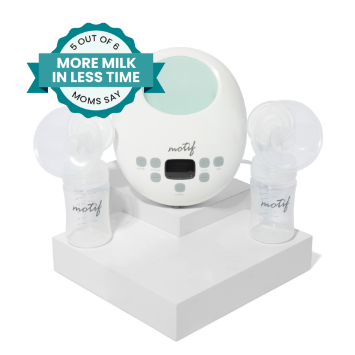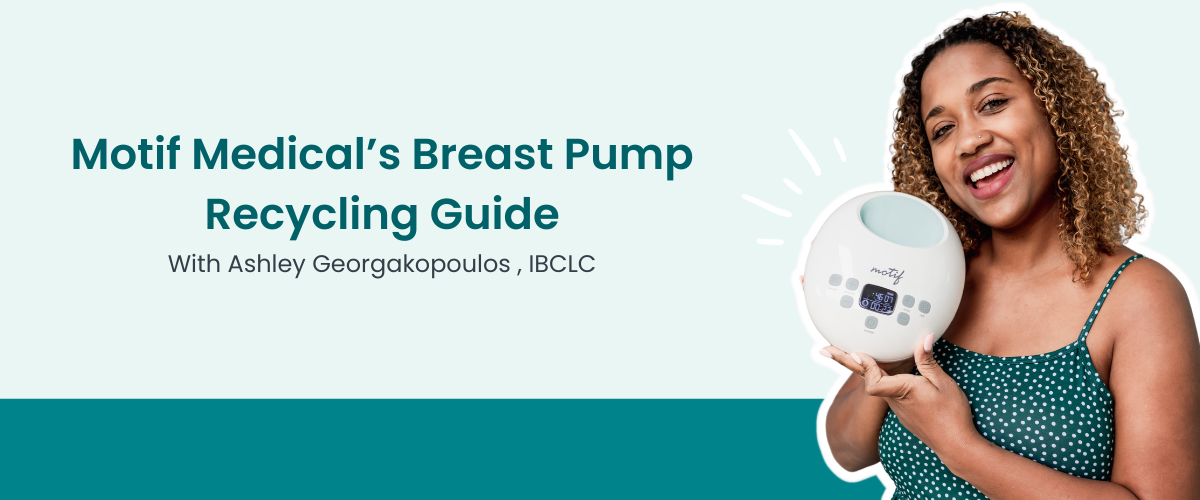Having a baby comes with plenty of new tasks and adjustments, but moms may not need to immediately start breast pumping. Milk supply concerns often make moms think otherwise.Unfortunately, pumping output is not a great gauge for total milk supply, especially not in the first days postpartum. Many new moms question if they're producing enough milk, which can lead to anxiety.
On the flip side, with pumps becoming more efficient than ever, if mom is breastfeeding AND pumping, it can result in an oversupply! It's basically telling the body to create milk for more babies than there actually is/are. Supply is demand-driven.
Should a mom implement a pumping routine, and if so when? While there isn’t an umbrella answer to this, here are some things to take into consideration.
Separation from Baby for 4+ Hours or More
- NICU stay
- Surgery (maternal or for the infant) that may cause delay at the breast
- Work or a night out
Milk removal should occur every 2-3 hours, sometimes even more often than that. If feeding is not an option for a length of time, it’s important to still have means to remove it and not let it sit stagnant in the breasts.
This prevents build up of FIL, a protein that communicates usage of milk or lack thereof, as well as preventing potential clogs from fatty milk. Milk flow also keeps the ducts and nipples flushed of bacteria and yeast that can cause mastitis and thrush.
When is Pumping Needed?
Low Breast Milk Supply
You may also consider pumping to boost your breast milk supply. Some common culprits behind low supply include:
- Poor/inconsistent latching
- Insufficient glandular tissue (IGT)
- Separation from baby
- Hormonal imbalances
- Heavy bleeding, severe hemorrhage
- Retained placental fragments
- Medication meant for drying up secretions, i.e. allergy and cold medications


Whether accidentally induced due to unforeseen obstacles or unavoidable ones, pumps are a great tool to incorporate more stimulation and milk removal. Even if milk removal or output does not occur right away, repetition and an intentional schedule and technique will encourage the body to take the hint and produce more milk.
Personal Preference / Exclusive Pumping (EP)
Some mothers truly feel uncomfortable feeding directly at the breast, whether due to a history of abuse, lack of support, or other reasons for aversion. Other mothers simply find exclusively pumping more conducive to their lifestyle and preferences!
Obstacles presented at the beginning of the breastfeeding relationship may lead to EP, and can work really well for the mother and baby/babies.
It’s beneficial to seek guidance from an IBCLC on exclusive pumping to maintain long term supply and reach breastfeeding goals.
When to Wait to Pump
Having a pump is a wonderful tool to keep on hand. Unforeseen obstacles happen quite often, and a good pump can really save a nursing relationship and a mother’s goals. Using the pump right out of the gate is not always necessary, however.
Is breastfeeding going well? For example:
- Breastfeeding is not painful
- Baby is gaining adequate weight
- There's no engorgement or mastitis
Are you planning on staying at home or have at least 4-6 weeks off from work? If your answer is “Yes,” that’s fantastic! Keep your preferred pump on hand, but do not feel pressured to have to incorporate using it right away.
How to Get Started
Choosing a Pump
A great time to start considering pumping and fit is in pregnancy. Many insurances now cover breast pumps, which can be acquired as early as the third trimester. Some things to consider when choosing the pump:
- How often will you be using the pump? Occasionally? For work?
- Size flange (nipple diameter in mm)
- Battery option needed?
Planned Pumping for Building a Stash
If you're building a milk stash for work or extended separation during the day, begin with 1-2 pump sessions a day 2 weeks before you need it. Mornings may work best, as there tends to be more volume to work with.
Things to keep in mind:
- Pumping sessions should be kept similarly to average feeding times, i.e. 15-20 minutes and at least every 2-3 hours
- A freezer-full of milk is NOT needed! The average amount needed for when away from baby is 1 oz for every hour away, i.e. 8 hour work day + 60 min commute total = 9 hours, 9-10 oz/day will do perfectly! PLUS you will continue to pump while away, not just for ahead of time.
- Keep items that smell like baby, like a onesie or a blanket, while pumping. This can help focus the body to respond to the pump!
- Pumping output does not gauge overall supply capabilities.
- A great pump is vital! A top choice is the Motif Luna Breast Pump. It’s compact, hospital-grade closed system breast pump with a quiet motor Shown to provide More Milk in Less Time® Eligible for coverage through health insurance!
Pumping for Immediate Needs
Needing to implement pumping right after birth? Incorporate breast massage and hands-on pumping techniques FIRST with each session, followed by pumping as needed, despite the pressure to immediately hook up to a pump. Mothers have colostrum the first 2-3 days postpartum until transition begins. This means small amounts will be located primarily behind the areola, not so much in the rest of the breast tissue. Priming with hands prior to using the pump can encourage better expression those first days.
Things to keep in mind:
- A baby’s stomach does not have the capability to stretch for at least 3 days. This means small amounts of colostrum/milk are perfectly appropriate to prevent spit up.
- Colostrum is very concentrated in calories, among other vital properties
- Pumping output can be improved when in the same room as the baby
- Mature milk takes 3-5 days to “come in”
Breastfeeding Schedules
Fortunately for us, healthy babies who are feeding and gaining well can be trusted to take the lead on when to eat. Feeding “on demand” is referring to this method. Active feeding, not counting time spent pacifying, occurs on average at least every 2-3 hours. However, because the baby also uses breastmilk for not only calories, but immunological help, as well as developmental, they may ask to feed more frequently or sporadically. By not keeping strict to a feeding routine, this need can be satisfied when needed.
Because breastmilk changes in concentration with the growing baby, the amount or volume does not dramatically increase, and therefore the frequency stays very similar throughout the first year. An exception to this is the newborn, because for the first few days the breast milk is still mostly colostrum, and they need even more frequent times at the breast.
The other exception is cluster feeding, which occurs at least 2-3 times. So, on average, a breastfed baby will need to feed every 2-3 hours, as previously mentioned, with subtle changes as they age, such as dropping a feed or two at night and spreading feedings out to 3-4 hours.
Of course, there are many circumstances in which scheduling is not only preferred, but necessary.
In some cases, such as prematurity, jaundice, tongue tie, and other issues that may contribute to complications gaining weight, implementing a schedule helps to keep track of feedings that can then be taken note of and reported. Ensuring that the baby does not surpass the typical timeframe in between feeds, as well noting how long it takes to complete the feed, can dramatically improve outcomes and avoid risks such as weight loss, low blood glucose, prolonged jaundice levels, and dehydration.
In the case of physical difficulties feeding, those rarely improve on their own and need to be monitored by their pediatrician, as well as in counsel with an IBCLC. An IBCLC can provide resources to not only address the issue(s) directly, but also provide ways to improve milk transfer and time spent at the breast in the meantime. One method to assist with this may be breast compression.
Pumping Schedules
Determining when to pump can feel overwhelming, but there is absolutely a method to the techniques and circumstances. First, determine the needs that pumping fulfills. Will it be an occasional need to bottle feed, or something more consistent, like returning to work or pumping full time? Regardless of the frequency needed, one rule will apply to any circumstance:
For every missed or skipped opportunity at the breast, pumping or expression needs to happen.
This is an especially important tip to keep in mind for those interested in having a partner or caregiver provide bottle feedings, such as at night, to let the mother rest or skip a feeding- it does not help the breast supply if some sort of expression is not occurring when appropriate. Even taking 5-10 minutes to pump in the middle of night is better than going hours without any removal of milk!
Occasional Bottle Feeding
For mothers who breastfeed and need only the occasional bottle supplied, fitting in 1-2 pumping sessions first thing in the morning tends to work the best for many. The milk supply tends to have more volume to work with in the earlier hours of the day, which makes it easier to pump out. Contrary to popular belief, as long as the baby eats well and effectively, it should not matter if the mother pumps and then feeds soon after, as the breasts are never truly empty once in lactation mode.
Having this simple schedule of once-a-day pumping makes it easy to gradually obtain a small stash to have on hand, without the risk of creating an oversupply. This can be implemented as early as 2-3 weeks postpartum, but is recommended to wait until needed so as not to put unnecessary stress on the mother.
Quick tip: Introducing a bottle between 4-6 weeks of age is ideal if the baby is ever to need a bottle in the future. This is an adaptable age to accept other forms of being fed, versus waiting too long and not taking the bottle well.
Full or Part-time Pumping and Bottlefeeding
In the case of needing to feed from a bottle more frequently, such as returning to work, or if the mother needs or desires to only pump, the pumping schedule needs to be structured and intentional. For the sake of breast milk supply, as well as the health and integrity of the mother and her breast tissue, pumping sessions should occur frequently, mimicking the natural feeding patterns of a breastfed baby.
The First Two Weeks
If needing to pump or express within this timeframe, it’s best to mimic the cluster-feeding patterns that the newborn would signal the mother. The first 3-5 days may still be colostrum and transitional milk, and may need both hand expression as well as pumping. The small volume of this type of milk means more frequent attempts to remove it. This looks like every 1-2 hours during the day, 2-3 at night.
Pumping Mature Milk
Natural feeding frequencies tend to space out more, finding a rhythm of feeding at least every 2-3 hours. The term “at least” re-emphasizing the fact that babies do, in truth, eat quite frequently, and will sometimes ask to eat in clusters. To best mimic this, pumping schedules need to be as close to this as possible. As the baby ages and milk supply stabilizes, this schedule can be eased into an every 3-4 hour layout. Babies may also drop a feeding at night, and so by 6 months, 1-2 night pumping sessions is perfect.
Being too strict on a schedule when the breasts feel uncomfortable and need relief is counterintuitive AND counterproductive. Remember, frequency, not volume, of stimulation and output is the best way to have a healthy supply! It also helps avoid problems such as mastitis and engorgement. Be sure to discuss pumping needs with employers, if applicable, and make this a priority.
Quick tip: Listen to your body. Do not wait to feel full to pump!
Power Pumping
Boosting supply therapeutically can be done through Power Pumping, which is typically a 10:10:10 format, 1-3 times a day. Twenty minutes of pumping broken up by a 5-10 minute rest time allows for a back-to-back frequency boost, giving the signal to the body to pick up the milk-producing pace. Results usually happen within the week.
Additional Tips and Sample Schedule
- Take time to properly fit breast flanges. This not only avoids pain and discomfort, but actually helps to pump more efficiently, saving time.
- Having a game plan and good pumping supplies makes the flow of the schedule much easier, too. (No pun, intended.) Battery-operated pumps stay charged for many sessions, meaning less cords to deal with, and the accessibility to make pumping happen virtually anywhere. Double-electric pumps allow for more milk to be expressed, and in less time, and time is so valuable.
- Milk storage bags travel nicely, and can be cool with an ice pack until able to be refrigerated. Breastmilk can be kept out at room temperature for up to 4 hours, which takes some of the stress and urgency away to immediately have access to a refrigerator.
Sample Pumping Schedule for Working Moms
6:00 AM – Wake, drink water, pump 15-20 min*
6:15 AM – Wash up, get dressed
6:30 AM – Feed baby at the breast, finish getting ready, eat breakfast
6:45 AM – Pack pump, flanges, storage bags/bottles for the day
7:15 AM – Commute *Replace 6 AM pumping for on-the-go with a battery-operated pump!
9:00 AM – 15 Minute pumping break or pump while checking email/paperwork to stay on the clock
12:00 PM – Lunch & Pump 15-20 min
3:00 PM – Final pump break (15-20 min)
5:00 PM – Commute home- option to pump or feed once reunited
While this is a sample of one circumstance, making pumping frequency is not as daunting as it sounds. Working with the workflow can make keeping up with pumping much easier, and set an example for balance for employers and coworkers, plus it can be used as a much-needed mental break.
While this is a sample of one circumstance, making pumping frequency is not as daunting as it sounds. A set workflow can make keeping up with pumping much easier, and set an example for balance for employers and coworkers. Plus it can be used as a much-needed mental break. Read here for lifestyle tips to make pumping an occurrence that helps letdown response and rather something to look forward to.
If you have more questions, the best option is always to see a lactation consultant!










